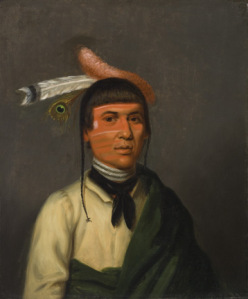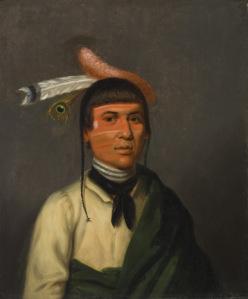
No-Tin, 1832-33
I am trying to decide where to hang a new American art acquisition—a portrait painted in 1832–33 by Henry Inman of Chippewa Chief No-Tin (which means "wind"). This is a particularly exciting process because this portrait is the first image of an identifiable American Indian to enter the collection. As soon as the painting returns from the objects conservation lab, where its frame is being repaired and cleaned, it can go up. The decision to place any work of art is always a challenge, but one I love: what is an appropriate context for the object for our galleries, which are organized roughly chronologically? Where will the painting look best? Do I have to move or remove anything to accommodate it? What impact would that have? What visual and/or thematic connections to surrounding works of art do I want to create? What histories about American art and experience can the art convey in this context? Answers to these questions are always subjective and depend on individual curators' perspectives, which can be controversial. (I recently wrote an article on the subject.) However, underlying all these factors informing a curator's decision is the fact that the historical object is always, inextricably removed from its original context once in the art museum. Are we trying to recreate that original context? Or rethink it? Trouble it? Draw attention to it? In the case of No-Tin, here is a portrait of a Chippewa chief who traveled with one of many Indian delegations to Washington, D.C., in the 1820s and 1830s as guests of the federal government. They sat for commissioned portraits destined for a national Indian Gallery. We could not recreate a portrait gallery of American Indians at LACMA, nor would we necessarily want to. What if I install the portrait of No-Tin prominently in our front gallery, with portraits of other eighteenth and nineteenth-century Americans, who were his previously unacknowledged contemporaries? I'll be thinking through these questions in the next few weeks, so check back to see where I end up installing No-Tin's portrait. Austen Bailly



